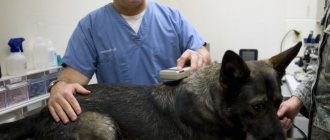The dog and the microbes that live on its surface can coexist peacefully for a long time. When immunity weakens for some reason, guests begin to actively reproduce, using the host as a breeding ground.
I will tell you what mycoplasma is, what diseases it causes in dogs, and what the main danger of the pathogen is. Can a person get infected from a pet? You will learn in which cases treatment of mycoplasmosis in the clinic is required, and when therapeutic procedures can be carried out at home.
What's happened
Mycoplasmas under a microscope.
Mycoplasma does not have a cell wall. The microbe takes the form of a mucosal cell, adheres to it, exchanges proteins, and consumes nutrients. Therefore, the immune system does not perceive mycoplasma as a foreign agent and antibodies are not produced.
However, healthy cells inhibit the proliferation of the microbe and the latent period of the disease can last for years without the manifestation of pathological symptoms.
Diagnostics
In the treatment of mycoplasmosis, early diagnosis . To do this, a clinical examination of the pet is initially carried out, followed by a clinical and biochemical blood test, serological tests, a clinical urine test, eye swabs, swabs from the bronchi and mucous membranes of the genitourinary organs, and a test for fluorescent antibodies. The diagnosis of mycoplasmosis is not made on the basis of just one analysis, since this disease is differentiated from infectious diseases of the upper respiratory tract, infections of the genitourinary system, endocrine diseases, and arthritis.
Causes and routes of infection
Mycoplasma is found in most dogs. But not everyone gets sick. Therefore, we are talking not so much about infection as about the activation of a microbe already present in the body.
Pay attention to the following reasons that increase your risk of getting sick:
- Inadequate feeding. A lack of vitamins and proteins disrupts the functioning of cell membranes, makes them vulnerable to attached microbes, and also weakens local immunity.
- Unsatisfactory maintenance - dirt, dampness, crowding, dustiness, stuffiness, drafts, concrete floors weaken the body's defenses.
- Stressful situations - transportation, sudden change of environment.
- Pregnancy - in order to prevent the walls of the uterus from rejecting the zygote, the body temporarily weakens the immune defense.
- Chronic diseases.
- Oncological pathologies.
- Random matings. The mucous membranes of the genitals are defenseless against mycoplasmas, as well as other pathogens of sexually transmitted infections.
Reasons for development
Reproduction of mycoplasma when the signs indicated in the “Symptoms” section appear can be suspected if the pet has recently undergone a course of antibiotic treatment as part of complex therapy for severe pathology. Against the background of decreased immunity, pathogenic and conditionally pathogenic fungi, bacteria, and dangerous viruses actively multiply. A visit to the veterinarian is mandatory if the animal communicates with cats or other dogs on the street.
Routes of infection:
- contact;
- airborne;
- through contaminated food.
The specific route of penetration depends on the characteristics of a particular type of mycoplasma.
Risk group:
- animals from kennels and dog shelters;
- dogs that have received blood transfusions;
- history of spleen disease;
- pets with weakened immune systems;
- dogs living in unsanitary conditions, not receiving the optimal type of food combined with poor animal care.
Symptoms
Signs of mycoplasmosis in dogs are nonspecific and appear at a late stage, when secondary microflora joins. Pay attention to the following symptoms:
- depressed state;
- redness of the sclera, lacrimation, purulent conjunctivitis;
- runny nose;
- digestive disorders, vomiting, abdominal pain;
- refusal to eat;
- stomatitis, gingivitis;
- thirst;
- painful urination;
- mastitis;
- abortions, birth of a non-viable or weak litter;
- intermittent fever;
- lameness;
- joints swollen, hot, painful;
- skin pathologies.
It is impossible to make a diagnosis based on clinical signs; laboratory tests are required.
Conjunctivitis is one of the symptoms of mycoplasmosis.
Other dogs and animals
Mycoplasmosis is transmitted exclusively from species to species. That is, from person to person, from one animal to another. So, cats become infected from each other, but they can also infect dogs. Because they are carriers of canine mycoplasmosis. Dogs also become infected from each other. Puppies can also become infected during birth if the mother is infected.
How dangerous is the disease?
The danger is as follows:
- Symptoms can be noticed when the disease reaches its final stage. By this time, secondary microflora joins, and irreversible changes occur in the organs.
- Antibodies are not produced against mycoplasmas. When the immune system detects a disorder in the body, it begins to produce globulins that kill its own cells affected by mycoplasma. An autoimmune disease develops, which leads to the formation of a malignant tumor.
- The non-enveloped bacterium is immune to many antibiotics, except those that interfere with the formation of connective tissue. This excludes the use of antimicrobial medications for young animals that have not finished growing, as well as lactating and pregnant bitches.
- Mycoplasmas produce ammonia and hydrogen peroxide. Metabolites damage adjacent cells and open the gates of infection for secondary microflora.
- The treatment is long-term. Even with the correct selection and dosage of medications, side effects develop that require long-term rehabilitation therapy.
- Mycoplasmosis in a pregnant dog is accompanied by damage to the uterine mucosa, which complicates pregnancy and disrupts the formation of fetuses. During whelping, babies become infected with mycoplasmas that live in the birth canal. The cubs' immune system is not ready to repel the threat.
Mycoplasmosis is especially dangerous for pregnant dogs.
Description
Mycoplasmas (prokaryotes) are small unicellular organisms widely distributed in nature. They are found in the body of humans and animals, on plants, in soil, etc.
They are often contained in the permanent flora of the mucous membranes of the upper respiratory tract, genital organs, and gastrointestinal tract in 70-80% of dogs. However, only 10% of carriers develop the disease. Infection, covering different parts of the body and organ systems, occurs with immunity deficiency, its suppression, and oncology.
By attaching to the host cell, mycoplasmas feed at its expense and obtain useful substances necessary for growth. “By masquerading,” they disrupt the process of recognizing substances and cells foreign to the body. This can cause an immune response to attack your own body (autoimmune process).
Mycoplasmosis is often accompanied by a secondary infection caused by bacteria. In this case, exudate with a large amount of fibrinogen is released, which protects mycoplasmas from attack by antibodies and the action of antimicrobial drugs. Therefore, it is difficult to treat the disease. Often it becomes chronic.
Pathological conditions develop under the influence of mycoplasma waste products. The infectious process spreads to the respiratory system, mammary glands, joints, genitals, nervous system, and urinary tract.
The disease affects both small and medium-sized dogs (Spitz, Pugs, etc.) and large ones (Labradors, Rottweilers, German Shepherds, etc.).
Treatment
Treatment is long-term and combines antimicrobial and symptomatic therapy. It is important to establish the underlying disease that caused weakened immunity and provoked mycoplasmosis. Without eliminating the main pathology, it is difficult to cope with mycoplasma. In any situation, antibiotic therapy is indicated.
The absence of a shell in mycoplasmas makes antimicrobial agents that destroy bacterial membranes useless. The causative agent of the disease is sensitive to the following injectable antibiotics:
- Doxycycline is an antibiotic from the tetracycline category. Destroys mycoplasmas, as well as secondary microflora that cause intestinal and respiratory diseases, arthritis and keratoconjunctivitis. Treatment consists of a single intramuscular injection followed by switching to tablet medications.
- Azitronit is an injectable azithromycin from the group of macrolides. They are pierced for 5 days in a row subcutaneously or intramuscularly, then switch to oral medications.
Mycoplasmas are sensitive to aminoglycosides and chloramphenicols, but their use is limited to topical or oral use.
At the same time, the veterinarian prescribes immunomodulators:
- Immunofan;
- Maxidin;
- Roncoleukin;
- Ribotan.
Depending on the symptoms, the veterinarian prescribes the following groups of medications:
- Eye drops Iris, Ofthalmosan, Diamond eyes, tetracycline eye ointment. Eye and intranasal drops Anandin, Maksidin.
- Medicines against the runny nose - Dioxidin, Galazolin, Pinosol, Derinat.
- Anti-inflammatory non-steroidal drugs for the treatment of joints - Tolfedin. Trokoksil. Corticosteroids are contraindicated because they lead to chronic lifelong diseases.
- Chondroprotector Chondrocan.
- Hepatoprotectors - Gepasafe; Hepatovet; Hepatoject; Liv 52 Vet.
- Probiotics - Vetkor; Vetom; Lactis zoo; Lactobifadol; Zoonorm.
- Diet food. I recommend Eukanuba Intestinal for dogs with digestive disorders or Hill's l/d for liver disease.
Treatment at home
If you detect at least a few of the symptoms listed above, go to the clinic, where they will conduct diagnostic tests and prescribe treatment. Self-medication can lead to a momentary improvement in the dog’s condition, but the disease becomes chronic and, with a high degree of probability, lifelong. Do not attempt to treat a female puppy. The risk of puppies appearing with congenital deformities or non-viable ones increases.
Therefore, at home, your task is to follow the orders of the veterinarian.
Treatment at a veterinary clinic
The clinic conducts tests, gives the first injections and prescribes treatment. If mycoplasmosis is diagnosed in a pregnant bitch, but you want to keep the puppies, a cesarean section is performed. Pregnant dogs cannot be treated with antibiotics, for the reason I mentioned above. The cubs are weakened by the inflammatory processes occurring in the uterus and are at risk of infection during passage through the birth canal.
Recovery after illness
The main side effects are caused by long-term use of antibiotics. Therefore, the liver is affected and intestinal dysbiosis develops. I recommend using the following groups of medications mentioned above:
- chondroprotectors;
- hepatoprotectors;
- probiotics;
- ready-made veterinary feeds.
If you prefer to feed naturally, consult your veterinarian about what vitamin supplements to use to restore strength after recovery.
Watch the video:
What type of mycoplasma is dangerous for dogs?
The most dangerous is Mycoplasma cynos, canis. And although it has been proven that microorganisms of these types can remain in the body for a long time without causing any harm to health, responsible owners are obliged to pay enough attention to strengthening the pet’s immunity, in particular, vaccination on schedule. Since mycoplasmas are opportunistic pathogens (organisms that can cause diseases only when certain negative factors coincide), stress, any infectious disease, immunodeficiency and even poor nutrition will lead to the development of mycoplasmosis. Close contact with other animals (especially if they live in enclosures) is also dangerous.
Interesting to know! Studies have proven that if a dog has a strong immune system, eats well and takes vitamin supplements, then infection will not lead to any serious consequences.
You should contact your veterinarian for testing for the presence of pathogenic bacteria if:
- a pregnant bitch is diagnosed with fetal resorption;
- the pet had close contact with mongrels;
- the animal regularly suffers from respiratory diseases.
Of course, the veterinarian will conduct the necessary tests after obvious symptoms appear, but it is better to take care of prevention in advance.
Prevention
The cause of the disease is weakened immunity. To ensure that your pet’s defense mechanisms are at the proper level, adhere to the following rules:
- Feeding. — I recommend using ready-made food of at least premium class. (see rating of premium, super-premium, holistic food). They are balanced in terms of nutrients and do not require modification. To prepare a complete diet from natural products, special knowledge is required. Adherents of natural food still cannot do without purchased feed additives.
- Contents - provide a place for the dog where it can hide from precipitation and drafts. Temperature is of secondary importance - dogs can heat themselves from the inside if they are fed correctly.
- Treatment against parasites. Regularly remove fleas, lice and ticks. Carry out quarterly preventive dewormings. (see the best remedies for worms, fleas and ticks, and ear mites).
- Follow your vaccination plan. Vaccination leads to strengthening of nonspecific immunity.
- Prepare thoroughly for mating. Vaccinate your dog additionally. Test both future partners for mycoplasma activity. Avoid accidental mating.
- Prevent stressful situations. Before travel or an exhibition, treat your dog with Stop-Stress or its equivalent.
- Carry out regular preventive examinations with a veterinarian.
I will answer questions in the comments.











